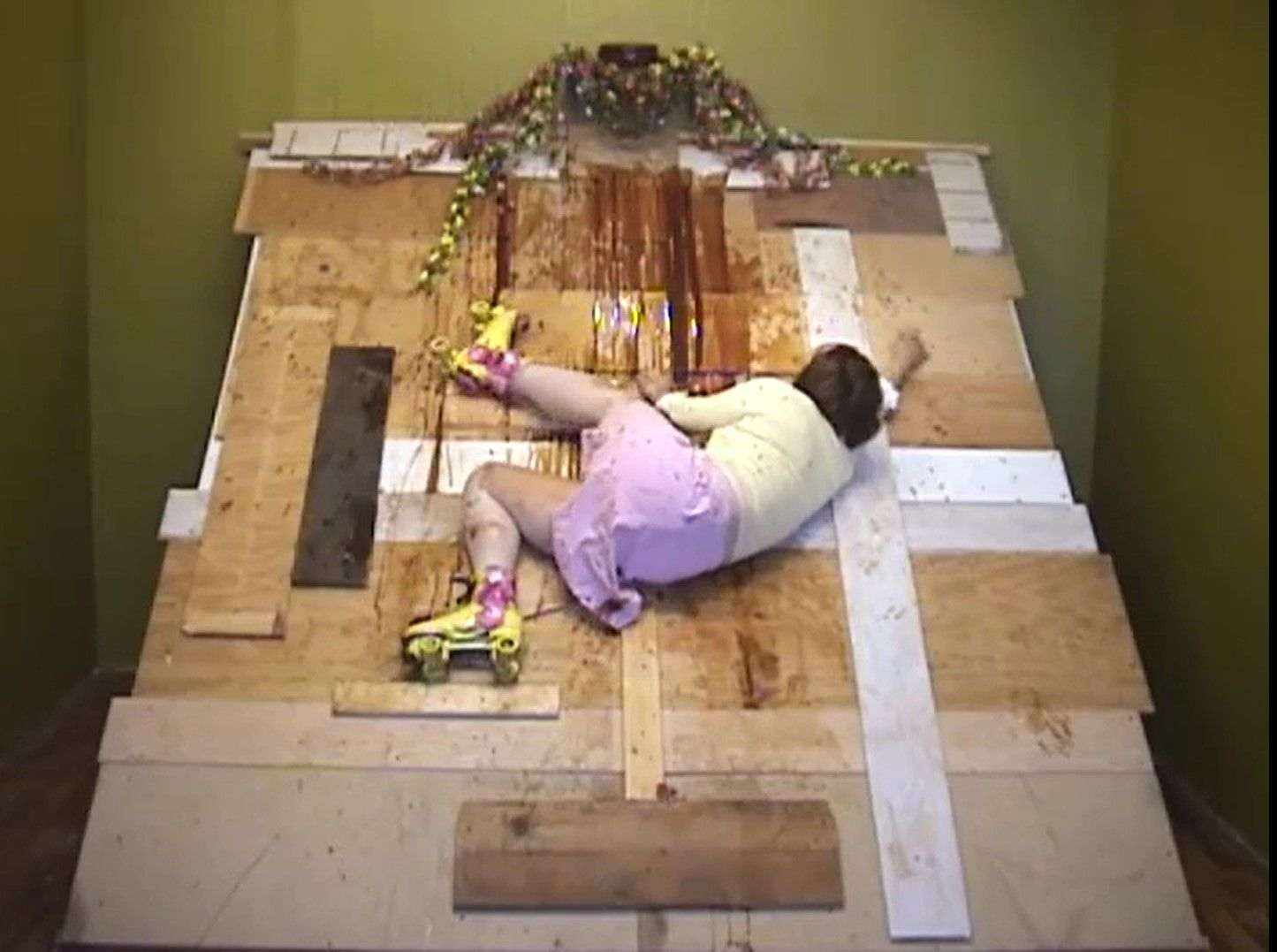Kate Gilmore (b. 1975) is a multidisciplinary artist specializing in installation, sculpture, performance, and video art. Born in Washington D.C., Gilmore earned her bachelor’s degree from Bates College in 1997 and her master of fine arts from the School of Visual Arts in 2002. She has exhibited work at the Whitney and Moscow Biennials and in solo exhibitions at the Everson, MoCA Cleveland, Aldrich Contemporary Art Museum, Public Art Fund at Byrant Park, Institute of Contemporary Art in Philadelphia, and the Contemporary Art Center in Cincinnati. Gilmore’s work challenges women’s bodies—often her own—literally, giving her heroines borderline ludicrous tasks to complete. Her art features brutal struggles with invented problems. She constructs daunting, physically demanding set pieces in her New York studio, and films herself as she struggles to complete each performance art “task.” These Sisyphean tasks always feature women in feminine clothing—dresses or skirts, high heels, and makeup. Gilmore’s tongue-in-cheek challenges speak to society’s impossible standards for a “successful woman,” but she also critiques her heroines who desperately claw their way toward feminine perfection. In Cake Walk, for example, Gilmore challenges herself to scale a vertical board with narrow ledges while wearing roller skates. The goal of Cake Walk is to reach the small chocolate cake at the summit of a tall ramp. Further challenging this task is the timed release of red wine, which makes the surface slippery. For over nine minutes Gilmore, dressed in a lavender skirt and a pale-yellow top, struggles to achieve her goal. Each of Gilmore’s falls and scrapes are viscerally felt by the viewer, as it is easy to imagine the hardness of the rough wood on her hands, and the pain to her knees with every bang and thump. Her clothes quickly become stained from the red wine constantly running down the wooden ramp. After several minutes of uncomfortable struggle, Gilmore is victorious. She wrenches the cake down in her fist, and the cake not squished in her fist falls to the floor. Yet she does not even enjoy her victory. Gilmore takes a final fall, landing out of frame. Gilmore’s performances are darkly funny. Cake Walk is both a literal and ironic description of her performance, as nothing about her climb looks easy. Viewers undoubtedly find that Gilmore’s struggle for the cake was not worth the time and effort it took to reach her prize. This is by design. Gilmore explains about her work, “We all know what it means to struggle, to ‘lose it.’” With Cake Walk, as soon as Gilmore reaches her goal the video loops. It starts again with Gilmore awkwardly stomping into frame, slightly off balance on her flower-decorated skates. The cake is at the top of a wooden ramp, and so Gilmore begins to climb. Cake Walk is on view in A Legacy of Firsts: The Everson Collects, an exhibition that examines over one hundred years of the Museum’s collecting priorities, from the Museum’s earliest acquisitions in 1911 to work acquired in 2019.
—Kelli Fisher, Curatorial Intern
Sources:1. Gilmore, Kate. “Kate Gilmore.” Last modified November 2019. http://www.kategilmore.com/.2. Institute of Contemporary Art: University of Pennsylvania. “Kate Gilmore.” Last modified December 7, 2008. http://icaphila.org/exhibitions/kate-gilmore-2/.3. The Philip and Muriel Berman Museum of Art at Ursinus College. “Kate Gilmore: Hard Work: Early Videos by Kate Gilmore.” Accessed October 23, 2020. https://www.ursinus.edu/live/profiles/4144-kate-gilmore/_ingredients/templates/berman-2018/exhibition.4. Re.Act Feminism: A Performing Archive. “Kate Gilmore: Cake Walk.” Accessed October 23, 2020. http://www.reactfeminism.org/entry.php?l=lb&id=62&e=t.


